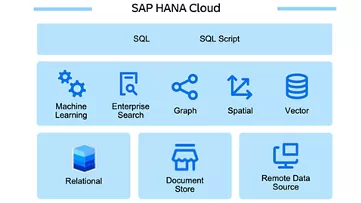Revolutionise ERP with SAP HANA Cloud Vector Engine
In modern times, everyone is looking for integrated, straightforward solutions, and SAP HANA Cloud Vector Engine, which just hit the market, is the most effective solution. This innovative system treats many data sorts as high-dimensional vectors and organises and analyses them, including text, photos, audio, and relational data. Its novel strategy transforms the ERP environment by giving AI models improved context and long-term memory.
Throughout this blog, we’ll look at the essential features, technological advances, and how SAP HANA Cloud Vector Engine might alter the way we live.

SAP HANA is well-known for its dynamic key characteristics, which distinguish it from other database and analytics solutions. Here are some of its most prominent features
1. In-Memory Computing: SAP HANA allows for real-time analytics and speedier processing by storing data in memory. Disc read delays are eliminated, resulting in faster insights and decision-making. A large retailer utilizes SAP HANA to analyse real-time customer buying patterns during peak shopping hours, enhancing efficiency, reducing out-of-stock situations, and increasing sales.
2. Advanced Analytics: By combining text analytics, spatial data processing, and predictive analytics, organisations may obtain a thorough understanding of their data, which helps them make well-informed strategic decisions. A hospital uses SAP HANA to analyse patient data, including doctor notes, imaging data, and disease outbreak predictions, to optimise resource allocation and enhance patient care quality.
3. Multi-Model Data Management: Relational, spatial, document, graph, and other data types can all be supported by SAP HANA in a single database. This adaptability improves operational efficiency and streamlines data handling. A logistics company utilizes SAP HANA to efficiently manage various data types, including relational, spatial, and document data, thereby reducing delays and costs.
4. Al Integration: SAP HANA makes predictive maintenance, automation, and intelligent data applications possible by facilitating Al and machine learning frameworks. The operational efficiency and business processes are improved by this linkage. An automotive manufacturer uses SAP HANA and Al to predict
machine maintenance needs, reducing downtime, preventing costly breakdowns, and ensuring smooth production processes.
5. Real-Time Data Processing: SAP HANA allows companies to respond quickly to new information by processing data in real-time. This enhances operational agility, reactivity, and potential to seize new possibilities. A stock trading firm uses SAP HANA to process real-time market data, enabling immediate trade execution and maximising profitability, thereby enhancing its competitive edge.

SAP HANA CLOUD



Some prominent business owners solved their operational challenges by integrating SAP HANA into their systems. For instance, in the motor oil industry, companies have utilised SAP HANA’s advanced analytics and real-time data processing to optimise production schedules and enhance product quality. In the National Hockey League (NHL), teams leverage SAP HANA for player performance analysis, fan engagement strategies, and real-time game statistics. Similarly, Team Liquid, a prominent esports organisation, integrates SAP HANA to manage and analyse vast amounts of data related to player performance, team strategies, and fan interactions, optimising their competitive edge in the esports arena. These case studies demonstrate SAP HANA’s versatility across diverse industries, driving innovation and efficiency.
Despite SAP HANA’s revolutionary capabilities, enterprises still face the following obstacles when using it:
• Difficult Implementation: Making the switch from outdated systems to SAP HANA can be difficult and disruptive.
• Scalability Issues: Making sure SAP HANA grows efficiently with rising data volumes
.• Cost management: controlling infrastructure and licencing expenses.
• Data Security: Making sure that there is strong data security and that regulations are followed.
Organisations should place a high priority on meticulous planning, phased deployment plans, ongoing performance and cost monitoring, and the implementation of strict security measures in order to overcome these obstacles. By taking these actions, organisations can minimise any potential downsides and optimise the advantages of SAP HANA.

SAP HANA’s future impact is expected to drive real-time analytics, AI integration, and data management innovations, enhancing operational efficiency and competitive advantage in business resource planning.
In conclusion, SAP HANA is an influential tool that alters the way enterprises manage data with its sophisticated in-memory computing, multi-model data management, and real-time analytics features. Proactive measures can guarantee a seamless transition and continued success even in the face of implementation, scalability, and cost management issues. SAP HANA’s function in enterprise resource planning is set to become more solid as it develops further. Its influence on data-driven decision-making and its ability to integrate with upcoming technologies will further improve operational efficiency and competitive advantage.


